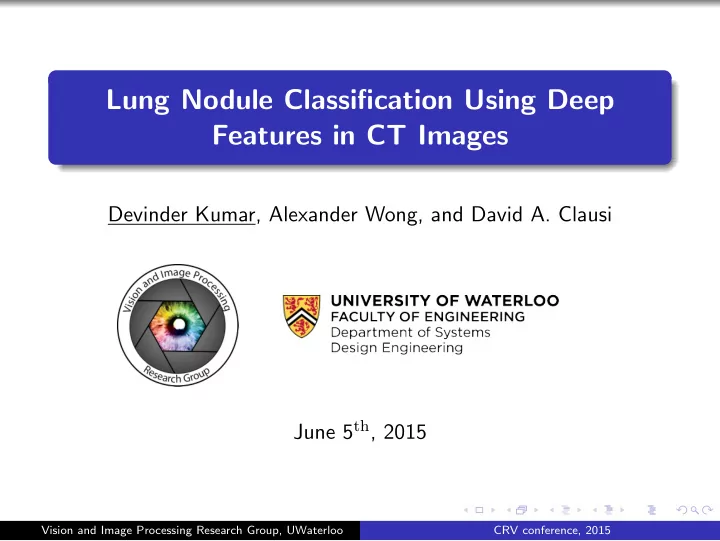

Lung Nodule Classification Using Deep Features in CT Images Devinder Kumar, Alexander Wong, and David A. Clausi June 5 th , 2015 Vision and Image Processing Research Group, UWaterloo CRV conference, 2015
Outline Why? Motivation What? Proposed Approach How? Exp. Setup So, What? Future Work Vision and Image Processing Research Group, UWaterloo CRV conference, 2015
Challenges and Motivation Why? Lung cancer results in 17% of total cancer related deaths. Early diagnosis required as it is harder to contain in later stages. Burden on doctors for early diagnosis. Untapped data is now available to build effective computer aided diagnosis (CAD) systems. Goal: second opinion ! Vision and Image Processing Research Group, UWaterloo CRV conference, 2015
Proposed Approach Build an effective CAD system to classify annotated nodules as malignant or benign using deep features extracted from autoencoder and binary decision tree as classifier. Figure : Proposed system flow diagram Vision and Image Processing Research Group, UWaterloo CRV conference, 2015
CAD system Design : Dataset LIDC-IDRI dataset Thoracic CT images of 1010 patients Diagnostic data for 157 patients avialable (ground truth) Ratings: 0-Unknown, 1-benign, 2-Primary malignant, 3-metastatic Annotations provided! Nodule size: 3 mm to 30 mm (A) (C) (B) (D) Figure : Annotations provided by four different radiologists Vision and Image Processing Research Group, UWaterloo CRV conference, 2015
CAD system Design : Autoencoder Design: Encoder Decoder Vision and Image Processing Research Group, UWaterloo CRV conference, 2015
Autoencoder Let input be f ( x i ) ǫ [0 , 1] d latent space y ǫ [0 , 1] d φ be non linear function y = φ ( Wf ( x i ) + b ) (1) Reconstruction: f ( x i ) ′ = φ ( W ′ y + b ′ ) (2) Error minimization: n � f ( x i ) ′ − f ( x i ) � 2 � min (3) W , b i =1 Vision and Image Processing Research Group, UWaterloo CRV conference, 2015
Stacked Autoencoder Figure : Stacked autoencoder formation Vision and Image Processing Research Group, UWaterloo CRV conference, 2015
Stacked Autoencoder Figure : Stacked autoencoder formation Vision and Image Processing Research Group, UWaterloo CRV conference, 2015
Stacked Autoencoder Figure : Stacked autoencoder formation Vision and Image Processing Research Group, UWaterloo CRV conference, 2015
Stacked Autoencoder Figure : Stacked autoencoder formation Vision and Image Processing Research Group, UWaterloo CRV conference, 2015
Stacked Autoencoder Our Design 3 Hidden layers layer size 200,100,200 Iteration set: 30 Batch size: 400 Feature extraction at 3rd hidden layer Vision and Image Processing Research Group, UWaterloo CRV conference, 2015
Experimental Setup Data: 4303 Instances (4323 nodules) Obtained from diagnostic data all provided annotation considered Rating: 1: benign & 0,2,3: malignant Feature extraction: features are extracted from 4th layer (3rd hidden layer) 200 dim. vector Training: 90% of 4303 Instances 10-fold cross validation Vision and Image Processing Research Group, UWaterloo CRV conference, 2015
Results 10 fold cross validation avg. : Accuracy: 75.01 Sensitivity: 83.35 FP/patient: 0.39 Belief Decision Trees 1 Deep Features Accuracy 75.01% 68.66% 1 D. Zinovev et al., Probabilistic lung nodule classification with belief decision trees in EMBC, 2011 Annual International Conference of the IEEE. IEEE, 2011, pp. 44934498 Vision and Image Processing Research Group, UWaterloo CRV conference, 2015
Results:Dificult cases Benign (a) (b) (c) malignant (d) (e) (f) Figure : significant visual similarities between the annotated nodules in (a,d), (b,e) and (c,f), making it very difficult to differentiate between such nodules during the classification process. Vision and Image Processing Research Group, UWaterloo CRV conference, 2015
So,What? Vision and Image Processing Research Group, UWaterloo CRV conference, 2015
Future Work different deep architectures (e.g. CNN) & more hidden layers i.e. very deep networks (16-19 layers) combination of features STAPLE SPIE lung nodule classification challenge Automatic nodule detection Vision and Image Processing Research Group, UWaterloo CRV conference, 2015
Thank you for listening! Contact: Devinder Kumar Email: devinder.kumar@uwaterloo.ca Vision and Image Processing Research Group, UWaterloo CRV conference, 2015
Recommend
More recommend